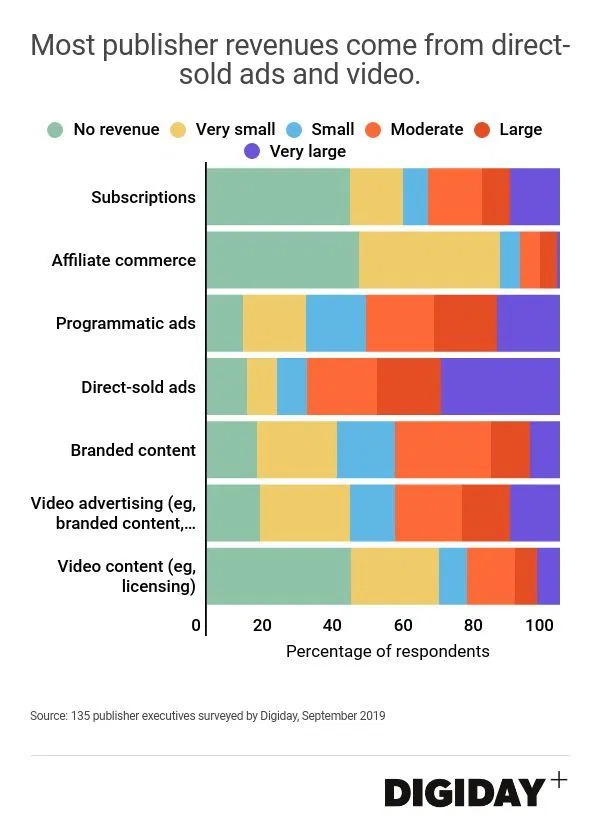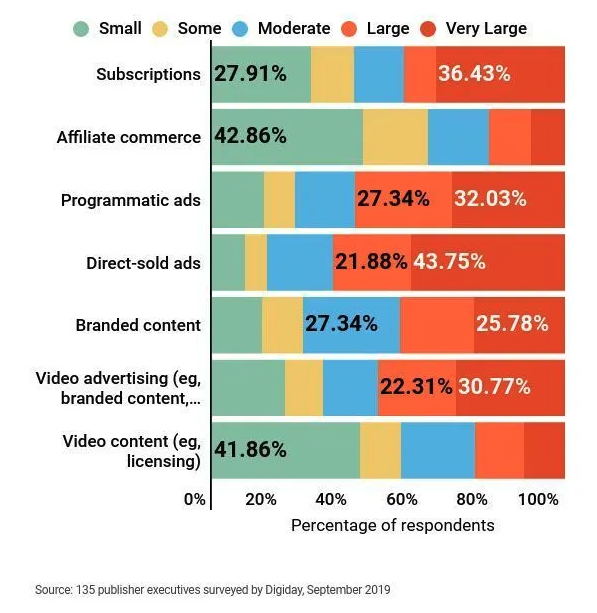Although the publishing industry’s digital transformation introduced a host of benefits to readers and media organizations alike, there’s no denying that it arrived with its own unique set of challenges. From declining display revenue to the mass adoption of ad blockers, today’s storytellers face a range of unfamiliar obstacles. The current climate has led publishers to explore a variety of alternative revenue streams, their sights set on replacing once-reliable sources of income. Leaning on two of their most valuable assets — storytelling expertise and hard-earned audience trust — many publishers have turned to branded content campaigns as a viable way to support their bottom lines.
Branded Content on the Rise
With some projecting native advertising will grow into a $400 billion global industry by 2025, publishers have been smart to jump on the branded content train while it’s still relatively “early.” And although branded content campaigns don’t bring in recurring revenue in the same way that, say, paid subscriptions do, they certainly make up for some of the dollars that would have historically come from display advertising. One need look no further than Bustle Digital Group, which, as of October 2019, attributed 75% of its revenue to direct-sold advertising, with 90% of that income involving some form of branded content creation. In fact, as you can see in the graphs below, most publishers are generating at least some revenue through branded content, and nearly half of publishers polled saw branded content as a “large” or “very large” priority heading into 2020.
Given the current branded content landscape and the likelihood that these campaigns will become even more prevalent in the coming years, it’s important for content creators and brands to understand the potential value that they have to offer — from a revenue perspective or otherwise.
Why Marketers Should Consider Branded Content Campaigns
By their definition, branded content campaigns involve a close partnership between a content creator and a brand advertiser. As with most business agreements, both parties involved in a branded content partnership enter into a deal expecting certain outcomes that will contribute in some way to them reaching their desired goals.
For publishers, the ultimate goal of participating in branded content campaigns usually boils down to revenue generation. As seasoned storytellers, publishers primarily benefit from these campaigns by charging brands for this expertise; by helping them weave a cohesive narrative that is both on-brand and on-message, typically steering clear of a “hard sell.” While the exact publisher contribution varies from deal to deal, a standard branded content partnership will usually leverage the publisher’s expertise across nearly all aspects of the partnership — everything from ideation, to asset creation, to distribution, and everything between.
There are other aspects of branded content campaigns that are advantageous to publishers, too:
- They provide value to readers — Yes, branded content usually incorporates some sort of product plug, but it will often offer something of value to the reader as well. For example, a cosmetics brand may partner with a fashion publisher to create a series of video makeup tutorials featuring the cosmetic brand’s products.
- They’re unobtrusive — Since branded content often mimics the look and feel of non-branded content that’s also created by a publisher, it tends to come across as unobtrusive to an audience.
- They’re authentic — Unlike other forms of advertising, branded content typically shares a similar tone of voice with the publisher’s other content that lends credibility and authenticity. Often, the most effective campaigns tout similar core beliefs and values that the publisher is known for espousing.
On the flip side, brand advertisers that approach publishers for branded content deals have goals that are more varied and can fluctuate from one campaign to another. At the end of the day, though, most of the time brands approach publishers for two main reasons: for help creating compelling content and to gain access to a publisher’s audience.
In addition to furthering a brands business goals, branded content campaigns offer advertisers:
- Borrowed credibility and value alignment — With branded content campaigns, brands are able to “borrow” the trust, credibility, and values that have already been established by the publisher.
- Access — As Nielsen points out, branded content campaigns give advertisers access to pre-existing content formats and known personalities that they would not likely have otherwise.
- Benefits not readily available in direct response advertising — These advantages include showing a product or service within a wider, real-life context as well as the option for longer-form video than standard direct response advertising.
What You Need to Get Started with Branded Content
Before taking the first step in creating a branded content campaign, it’s smart to consult with the relevant data. Monica Hare from Gear Patrol Studios succinctly explained the importance of this process in her Storytellers Series interview:
“When we’re pitching creative ideas, it’s so much more powerful when the ideas are backed up by meaningful data. It can be a key insight into human behavior, for example, or specifics about the audience that we help the brand reach.”
One key factor that both parties need to consider before partnering on a campaign is the content’s tone of voice. For the piece to feel natural (and ultimately, for it to be successful), the voices of the two partners should blend together. Of course, the voice of the branded piece might be different from each company’s individual voices, but the content tends to be stronger when the voice is well balanced.
When it comes to specific steps, most branded content campaigns that we’ve been involved with tend to follow this general outline:
- Understand Your KPIs
How will you know if a campaign is successful unless you have goals in place to measure success in the first place? In order to run an effective branded content campaign, both partners must be very tuned into their performance metrics and targeting capabilities before distribution comes into play. Common KPIs include metrics like reach, engagement, brand linkage, and sentiment. - Produce Powerful Content
To bring the content to life in a way that makes the most sense for a specific campaign, focus first on the story or message that you are trying to convey. Once that’s in place, hone in on the best format to communicate the piece. - Utilize Sophisticated Distribution Techniques
It’s important to remember to distribute content in a way that makes sense with both the content format and the brand advertiser’s goals. When paying for distribution, it is crucial to regularly check on campaigns to ensure tracking is set up correctly toward your KPIs. Each channel should also be evaluated for its audiences in order to make sure that you’re reaching audiences that truly value the content. - Demonstrate Success to Brand Advertisers
By making sure that the campaign tracking is in order, you should have a complete data set of accurate reporting and reliable metrics to demonstrate success. Conducting and illustrating a campaign that reached its desired goals can open you to more opportunities in the future.
A Perfect Pairing: Paid Distribution and Branded Content
Marketers who rely on organic reach alone often find themselves struggling to move the needle with their branded content campaigns. Fortunately, distributing content in a controlled, scalable way is more manageable than ever thanks to paid social channels. With paid distribution, a publisher and partner brand can both rest assured knowing that their expectations have a high likelihood of being met (or surpassed).
Another advantage of employing paid distribution is that the process can be catered around specific business goals, whether it be brand awareness or lead generation. These goals inform every distribution targeting and strategy to produce the desired engagement rather than simply targeting to generate the cheapest clicks or views possible.
At Keywee, we help storytellers cost-effectively distribute their (branded) content through paid channels on platforms like Facebook and Instagram. If you’d like to learn more about how we can help you scale your branded content campaigns, please reach out.



